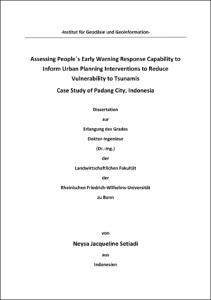Setiadi, Neysa Jacqueline: Assessing People´s Early Warning Response Capability to Inform Urban Planning Interventions to Reduce Vulnerability to Tsunamis : Case Study of Padang City, Indonesia. - Bonn, 2014. - Dissertation, Rheinische Friedrich-Wilhelms-Universität Bonn.
Online-Ausgabe in bonndoc: https://nbn-resolving.org/urn:nbn:de:hbz:5n-35029
Online-Ausgabe in bonndoc: https://nbn-resolving.org/urn:nbn:de:hbz:5n-35029
@phdthesis{handle:20.500.11811/5829,
urn: https://nbn-resolving.org/urn:nbn:de:hbz:5n-35029,
author = {{Neysa Jacqueline Setiadi}},
title = {Assessing People´s Early Warning Response Capability to Inform Urban Planning Interventions to Reduce Vulnerability to Tsunamis : Case Study of Padang City, Indonesia},
school = {Rheinische Friedrich-Wilhelms-Universität Bonn},
year = 2014,
month = mar,
note = {In the last decade, more emphasis is given on the human aspect of early warning or the attribute of “people-centered” early warning systems. This study seeks to better understand the specific conditions that shape people´s vulnerability in relation to their tsunami early warning response capability. The study lays emphasis on the bottlenecks within social conditions, issues of perception, and their linkages with urban evacuation spatial and infrastructure requirements. The study is based on an in-depth case study of the coastal city of Padang, Indonesia.
Founded on literature study on vulnerability and early warning concepts, a conceptual study was developed. Here, vulnerability was defined as “the conditions which influence the level of exposure and capability of people to respond to the warning and conduct appropriate evacuation, and in the long term, to change those conditions and enhance their response capability”. The study is composed of three main assessment blocks: i) current spatial hotspots and bottlenecks within social conditions assessments; ii) assessment of perception issues related with on-going or planned interventions; and iii) assessment of urban planning´s role and influence on vulnerability and people´s response capability. The first assessment block consists of spatial and temporal distribution of various social groups in the exposed areas (dynamic exposure); their access to safe places; their access to warning; and their evacuation behaviour. The second assessment block examines various cognitive factors connected with objective knowledge as well as socio-psychological factors pertaining to vulnerability reduction. These are intention to evacuate (reactive action) and intention to support improvement of evacuation infrastructure and facilities (proactive action). Moreover, perceptions connected with challenges of possible relocation as well as overall tsunami preparedness are explored. The third assessment block explores the urban planning´s role and interventions linked with various response capability components. In order to assess different thematic areas, an interdisciplinary approach is required, using engineering and social behavioural sciences approaches. Therefore, the combination of qualitative and quantitative data collection and analysis methods is used.
The results show that Padang´s current response capability varies according to its spatial and infrastructure setting as well as people´s socio-economic characteristics. Evacuation facilities and infrastructure were still lacking and their utilization was influenced by social conditions of the people. This implied a significant role for urban planning which needs to take into account various social groups´ specific needs while incorporating the importance of strategic risk communication within various interventions. The assessment needs to be integrated in the overall urban planning process and may provide guidance in finding the balance between long-term exposure reduction in dangerous areas and additional protection measures for mass evacuation.},
url = {https://hdl.handle.net/20.500.11811/5829}
}
urn: https://nbn-resolving.org/urn:nbn:de:hbz:5n-35029,
author = {{Neysa Jacqueline Setiadi}},
title = {Assessing People´s Early Warning Response Capability to Inform Urban Planning Interventions to Reduce Vulnerability to Tsunamis : Case Study of Padang City, Indonesia},
school = {Rheinische Friedrich-Wilhelms-Universität Bonn},
year = 2014,
month = mar,
note = {In the last decade, more emphasis is given on the human aspect of early warning or the attribute of “people-centered” early warning systems. This study seeks to better understand the specific conditions that shape people´s vulnerability in relation to their tsunami early warning response capability. The study lays emphasis on the bottlenecks within social conditions, issues of perception, and their linkages with urban evacuation spatial and infrastructure requirements. The study is based on an in-depth case study of the coastal city of Padang, Indonesia.
Founded on literature study on vulnerability and early warning concepts, a conceptual study was developed. Here, vulnerability was defined as “the conditions which influence the level of exposure and capability of people to respond to the warning and conduct appropriate evacuation, and in the long term, to change those conditions and enhance their response capability”. The study is composed of three main assessment blocks: i) current spatial hotspots and bottlenecks within social conditions assessments; ii) assessment of perception issues related with on-going or planned interventions; and iii) assessment of urban planning´s role and influence on vulnerability and people´s response capability. The first assessment block consists of spatial and temporal distribution of various social groups in the exposed areas (dynamic exposure); their access to safe places; their access to warning; and their evacuation behaviour. The second assessment block examines various cognitive factors connected with objective knowledge as well as socio-psychological factors pertaining to vulnerability reduction. These are intention to evacuate (reactive action) and intention to support improvement of evacuation infrastructure and facilities (proactive action). Moreover, perceptions connected with challenges of possible relocation as well as overall tsunami preparedness are explored. The third assessment block explores the urban planning´s role and interventions linked with various response capability components. In order to assess different thematic areas, an interdisciplinary approach is required, using engineering and social behavioural sciences approaches. Therefore, the combination of qualitative and quantitative data collection and analysis methods is used.
The results show that Padang´s current response capability varies according to its spatial and infrastructure setting as well as people´s socio-economic characteristics. Evacuation facilities and infrastructure were still lacking and their utilization was influenced by social conditions of the people. This implied a significant role for urban planning which needs to take into account various social groups´ specific needs while incorporating the importance of strategic risk communication within various interventions. The assessment needs to be integrated in the overall urban planning process and may provide guidance in finding the balance between long-term exposure reduction in dangerous areas and additional protection measures for mass evacuation.},
url = {https://hdl.handle.net/20.500.11811/5829}
}






